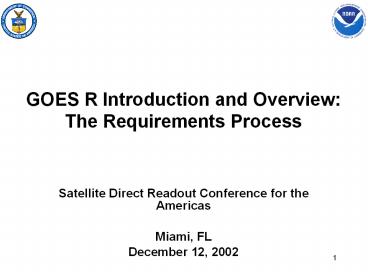GOES R Introduction and Overview: The Requirements Process - PowerPoint PPT Presentation
1 / 24
Title:
GOES R Introduction and Overview: The Requirements Process
Description:
Current instruments technology and parts obsolescence. 5 ... Processing & Communication Technologies. End-to-End Architectures. Architecture Solutions ... – PowerPoint PPT presentation
Number of Views:27
Avg rating:3.0/5.0
Title: GOES R Introduction and Overview: The Requirements Process
1
GOES R Introduction and Overview The
Requirements Process
- Satellite Direct Readout Conference for the
Americas - Miami, FL
- December 12, 2002
2
Integrated Approach to Observations
User Needs
Other Data
Other Satellites NASA DoD International Commer
cial
Geostationary GOES I-Series (Today) GOES
N-Series (2004) GOES R-Series (2012)
Polar POES (Today) w/METOP (2005) NPOESS (2009)
3
GOES Launch Planning
- Availability Planning Launch Satellite Date Dat
e - GOES N Jan 2004 Apr 2004
- GOES O Apr 2005 Apr 2007
- GOES P Apr 2007 Oct 2008
- GOES R Apr 2012 Apr 2012
- GOES S Apr 2013 Apr 2015
4
Need for GOES R Advanced Instruments
- Current Imager cannot monitor developing severe
local storms and still provide simultaneous
global surveillance and products - Current Sounder cannot see CONUS and ocean area
in time required - Imager resolution insufficient to see details of
storm formation wind accuracy too low for new
model requirements - Vertical moisture structure inadequately measured
improvements needed for flash flood forecasts
and severe weather information modeling - Current Imager has limited ability to monitor
volcanic ash, aviation icing hazards, snow/cloud
discrimination, mid-level moisture tracking - Current instruments technology and parts
obsolescence
5
GOES A Critical Asset in Hurricane Forecasting
Hurricane Floyd
6
1997-98 El Nino Winter Storm Forecasting
GOES Atmospheric moisture during El Nino Winter
Storms of December 1997
7
2 Satellite GOES-R Architecture
West
East
8
First Solar X-Ray Imager (SXI) Image September 7,
2001
9
Opportunities Challenges for GOES-R
10
Opportunities Challenges for GOES-R
11
Opportunities Challenges for GOES-R
12
Opportunities Challenges for GOES-R
13
Multi-Satellite GOES-R Architecture
West
East
- Additional Instruments could be flown on existing
satellites or as free-flyers - Microwave Sounder - Coronagraph
- Lightning Mapper
14
Requirements Flow to GOES-R Architecture
Development
User Needs
Potential solutions to fulfill mission needs
- End-to-End Systems
- Space Launch
- Command Control
- Product Generation Distribution
- Archive Access
- User Interface Assimilation
Architecture I 2 GEO Satellite Constellation
Architecture II Multi-Satellite Constellation
Architecture III Med Earth Orbit Constellation
Comprehensive assessment with Cost Benefit
Analysis as cornerstone
Recommend Alternative(s)
15
Cost and Benefit Analysis Strategy/Methodology
- Focus analysis on determining
- Linkages from improved GOES-R sensors to economic
benefits - Avoidable economic losses due to improved
advanced warnings of events and improved forecast
accuracy - Characterize information flow from sensors to
"end-users - Determine impacts of the instrument improvements
on our products - current emphasis on ABI/HES - Identify key benefit domains
- Hold user forums to elicit insight into improved
product benefits
16
Benefit Areas Investigated
- Agriculture
- Reduction of temperature error
- Reduce unnecessary and expensive frost/freeze
mitigation activities - Improved soil moisture measurement accuracy
- Reduce over-irrigation
- Aviation
- Improve convective weather forecasts
- Improve route planning
- Reduce delays/deviations/cancellations reduce
fuel consumption - Volcanic Ash Avoidance
- Reduce M in damage and potential loss of lives
17
Dust Over Southwest U.S.
18
Volcano Detection Tracking
February 2001, Mount Cleveland Eruption
19
Benefit Areas Investigated
- Recreational Boating
- Improve hurricane lead time Reduce boat loss and
damage - Trucking
- Improve severe weather lead time / location
Reduce of accidents/deaths - Utilities (Electric, Natural Gas)
- Improve temperature accuracy Improve load
forecasting and reduce expensive spot purchases
20
Ongoing Benefit Areas Analysis- Not Yet Included
in Report
- Commercial Shipping
- Improve tropical cyclone track and intensity
forecasts Improve ship routing - Emergency Management
- Increase lead time on severe weather forecasts
and hazardous environmental matter Improve
planning and deployment
21
Economic Benefits Summary for GOES-R Series
(2013-2027)
These benefits are over and above those achieved
by the current GOES baseline
22
GOES-R System Selection Timeline
Variety of Instrument Combinations
3 Basic Space Architectures
Variety of Ground Architectures
Sep 04
Dec 05
Apr 03
Architecture I 2 GEOs
Cost Performance Spectrum
Architecture II Multi-Satellites
Architecture III MEOs
23
GOES R Planning Schedule
24
Goal - Transition from Individual Systems to
System of Systems Architecture
Integrated System
Programs formulated independent of one another
Programs formulated as one integrated system































